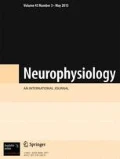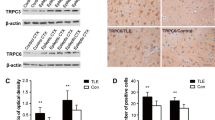We examined changes in expression of the candidate plasticity-related gene 15 (CPG15) in the dentate gyrus (DG) and hippocampal CA3 region in the pentylenetetrazole (PTZ) kindling model and investigated the role of this gene in the phenomenon of mossy fiber sprouting (MFS). Experimental rats were divided into the control and PTZ groups. The epileptic model was created by intraperitoneal PTZ injection, while control rats were injected with saline. At days 3, 7, 14, 28, and 42 after the first PTZ injection, Timm staining was scored in the CA3 hippocampal area, and a product of CPG15 (protein CPG15) was labeled in the DG stratum granulosum and in the CA3 area using immunohistochemistry. The Timm scores in the CA3 region increased gradually from day 3 and were significantly higher than those in the control within the subsequent period. The level of CPG15 protein in the DG and CA3 area decreased gradually until day 14 and returned to the normal level at day 28. The results obtained indicate, for the first time, that CPG15 may be involved in the process of MFS. Understanding the molecular mechanisms underlying this phenomenon may lead to successful therapeutic interventions that limit epileptogenesis.
Similar content being viewed by others
References
L. P. Andrade-Valenḉa, M. M. Valenḉa, T. R. Velasco, et al., “Mesial temporal lobe epilepsy: clinical and neuropathologic findings of familial and sporadic forms,” Epilepsia, 6, 1046-1054 (2008).
S. R. Lamont, B. J. Stanwell, R. Hill, et al., “Ketamine pretreatment dissociates the effects of electroconvulsive stimulation on mossy fiber sprouting and cellular proliferation in the dentate gyrus,” Brain Res., 1053, 27-32 (2008).
L. W. Kuo, C. Y. Lee, J. H. Chen, et al., “Mossy fiber sprouting in pilocarpine-induced status epilepticus rat hippocampus: a correlative study of diffusion spectrum imaging and histology,” NeuroImage, 41, 789-800 (2008).
R. Koyama and Y. Ikegaya, “Mossy fiber sprouting as a potential therapeutic target for epilepsy,” Current Neurovascul. Res., 1, No. 1, 3-10 (2004).
H. Lin, Y. Huang, Y. Wang, and J. Jia, “Spatiotemporal profile of N-cadherin expression in the mossy fiber sprouting and synaptic plasticity following seizures,” Mol. Cell. Biochem., 358, Nos. 1/2, 201-205 (2011).
A. J. Holtmaat, J. A. Gorter, J. De Wit, et al., “Transient downregulation of Sema3A mRNA in a rat model for temporal lobe epilepsy. A novel molecular event potentially contributing to mossy fiber sprouting,” Exp. Neurol., 182, 142-150 (2003).
R. Koyama, M. K. Yamada, N. Nishiyama, et al., “Brainderived neurotrophic factor induces hyperexcitable reentrant circuits in the dentate gyrus,” J. Neurosci., 24, No. 33, 7215-7224 (2004).
E. Nedivi, D. Hevroni, D. Naot, et al., “Numerous candidate plasticity-related genes revealed by different cDNA cloning,” Nature, 363, No. 6431, 718-722 (1993).
A. Javaherian and H. T. Cline, “Coordinated motor neuron axon growth and neuromuscular synaptogenesis are promoted by cpg15 in vivo,” Neuron, 45, 505-512 (2005).
T. Fujino, J. H. Leslie, R. Eavri, et al., “CPG15 regulates synapse stability in the developing and adult brain,” Genes Dev., 25, 2674-2685 (2005).
U. Putz, C. Harwell, and E. Nedivi, “Soluble CPG15, expressed during early development, rescues cortical progenitors from apoptosis,” Nat. Neurosci., 8, 322-331(2005).
F. F. Tian, C. Zeng, Y. E. Ma, et al., “Potential roles of Cdk5/p35 and tau protein in hippocampal mossy fiber sprouting in the PTZ kindling model,” Clin. Lab., 56, 127-136 (2010).
G. L. Holmes, M. Sarkisian, Y. Ben-Ari, and N. Chevassus-Au-Louis, “Mossy fiber sprouting after recurrent seizures during early development in rats,” J. Comp. Neurol., 404, 537-553 (1999).
J. E. Cavazos and D. J. Cross, “The role of synaptic reorganization in mesial temporal lobe epilepsy,” Epilepsy Behav., 8, 483-493 (2006).
L. H. Zeng, N. R. Rensing, and M. Wong, “The mammalian target of rapamycin signaling pathway mediates epileptogenesis in a model of temporal lobe epilepsy,” J. Neurosci., 29, 6964-6972 (2009).
F. H. Lew and P. S. Buckmaster, “Is there a critical period for mossy fiber sprouting in a mouse model of temporal lobe epilepsy?” Epilepsia, 52, No. 12, 2326-2332 (2011).
J. Nissinen, K. Lukasiuk, and A. Pitkanen, “Is mossy fiber sprouting present at the time of the first spontaneous seizures in rat experimental temporal lobe epilepsy?” Hippocampus, 11, 299-310 (2001).
C. Heinrich, S. Lahteinen, F. Suzuki, et al., “Increase in BDNF-mediated TrkB signaling promotes epileptogenesis in a mouse model of mesial temporal lobe epilepsy,” Neurobiol. Dis., 42, No. 1, 35-47 (2011).
B. Paradiso, S. Zucchini, T. Su, et al., “Localized overexpression of FGF-2 and BDNF in hippocampus reduces mossy fiber sprouting and spontaneous seizures up to 4 weeks after pilocarpine-induced status epilepticus,” Epilepsia, 52, No. 3, 572-578 (2011).
C. A. Altar, P. Laeng, L. W. Jurata, et al., “Electroconvulsive seizures regulate gene expression of distinct neurotrophic signaling pathways,” J. Neurosci., 24, No. 11, 2667-2677 (2004).
R. M. Risbud, C. Lee, and B. E. Porter, “Neurotrophin-3 mRNA a putative target of miR21 following status epilepticus,” Brain Res., 14, No. 24, 53-59 (2011).
22.T. Fujino, W. A. Lee, and E. Nedivi, “Regulation of cpg15 by signaling pathways that mediate synaptic plasticity,” Mol. Cell Neurosci., 24, 538-554 (2003).
G. S. Naeve, M. Ramakrishnan, R. Kramer, et al., “Neuritin: a gene induced by neural activity and neurotrophins that promotes neuritogenesis,” Proc. Natl. Acad. Sci., 94, No. 6, 2648-2653 (1997).
I. Cantallops and H. T. Cline, “Rapid activity-dependent delivery of the neurotrophic protein CPG15 to the axon surface of neurons in intact Xenopus tadpoles,” Dev. Neurobiol., 68, No. 6, 744-759 (2008).
E. Nedivi, G. Y. Wu, and H. T. Cline, “Promotion of dendritic growth by CPG15, an activity-induced signaling molecule,” Science, 281, No. 5384, 1863-1866 (1998).
Author information
Authors and Affiliations
Corresponding author
Rights and permissions
About this article
Cite this article
Song, M.Y., Tian, F.F., Dang, J. et al. Possible Role of Protein CPG15 in Hippocampal Mossy Fiber Sprouting Under Conditions of Pentylenetetrazole Kindling. Neurophysiology 47, 271–276 (2015). https://doi.org/10.1007/s11062-015-9533-y
Received:
Published:
Issue Date:
DOI: https://doi.org/10.1007/s11062-015-9533-y




